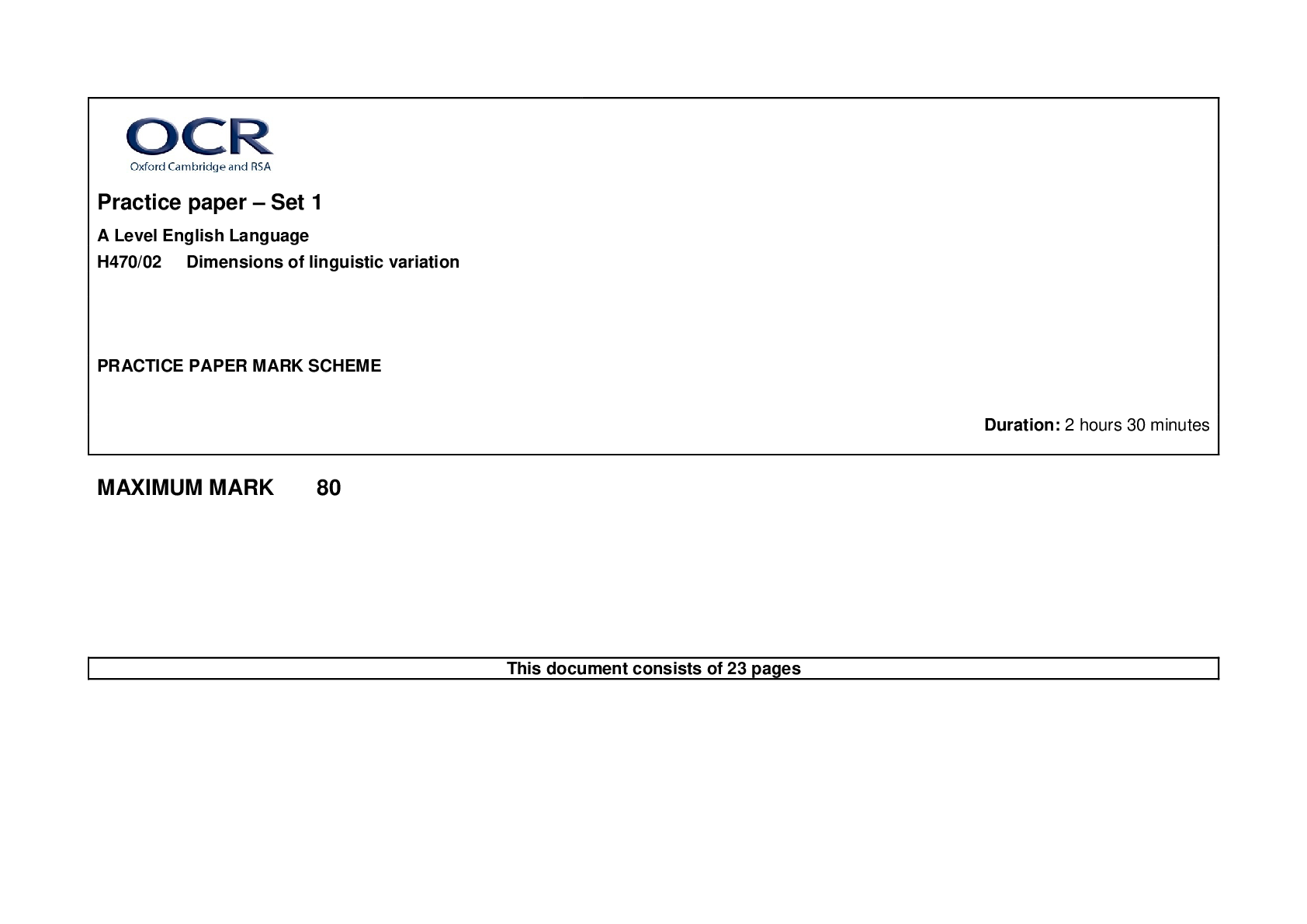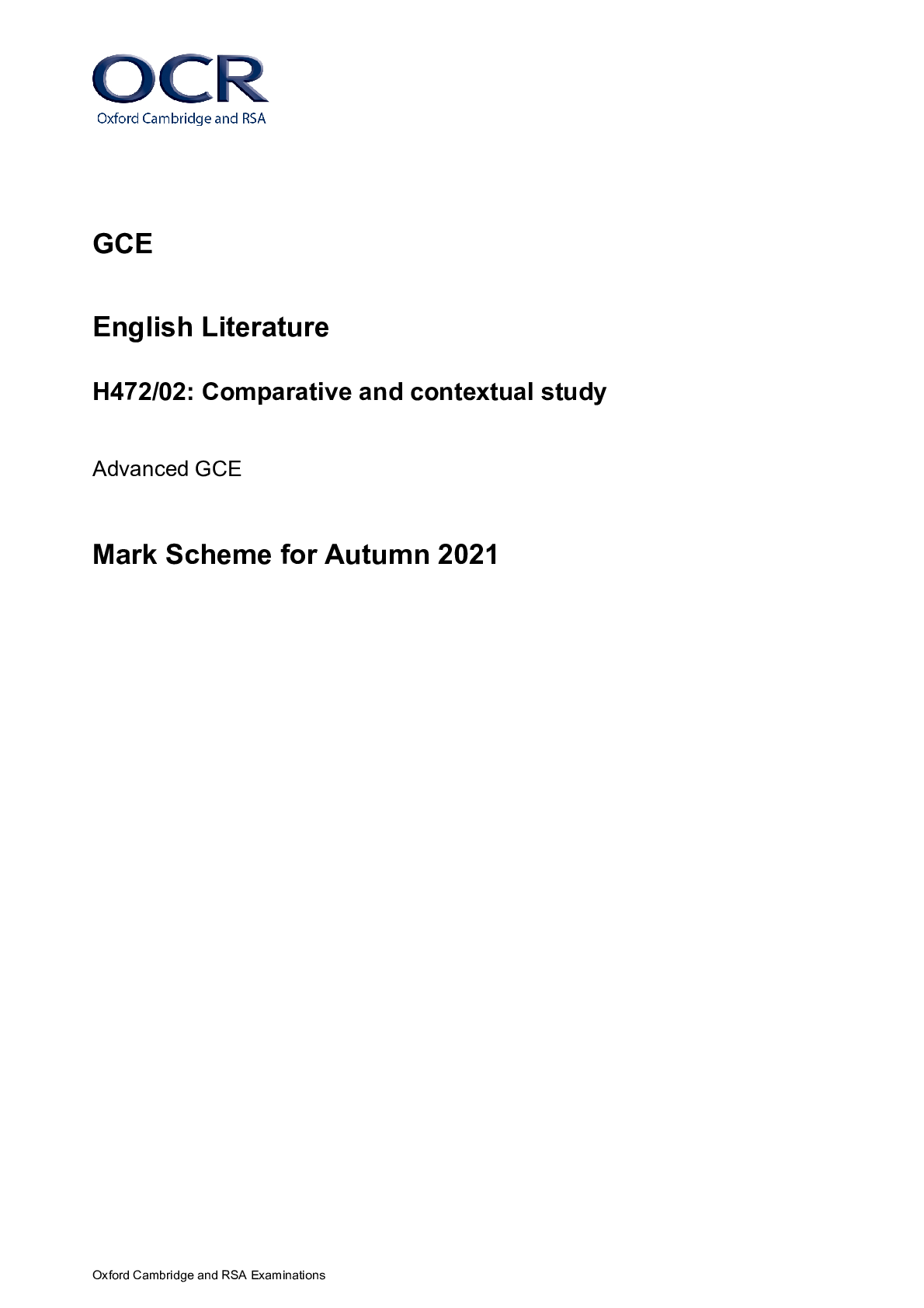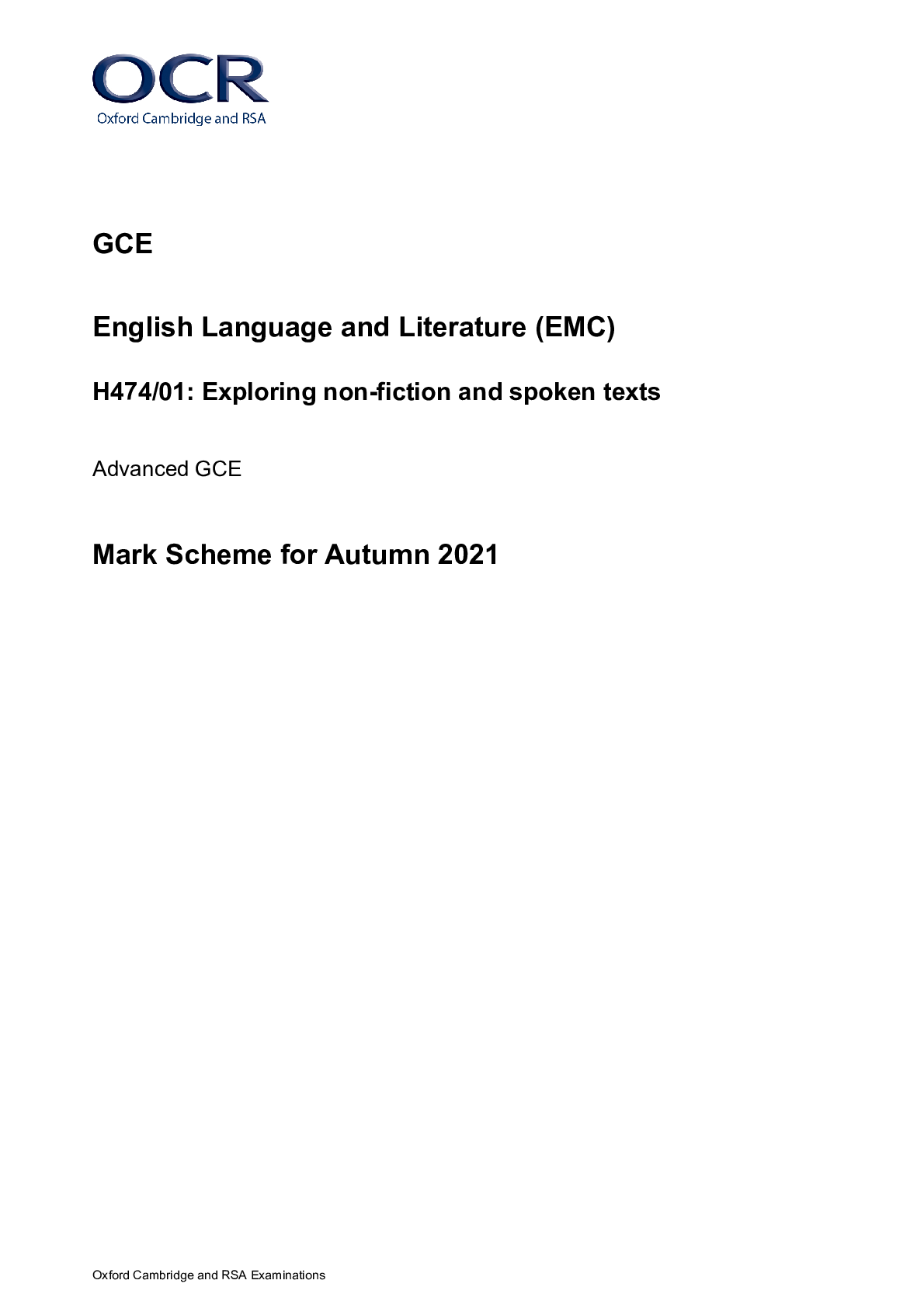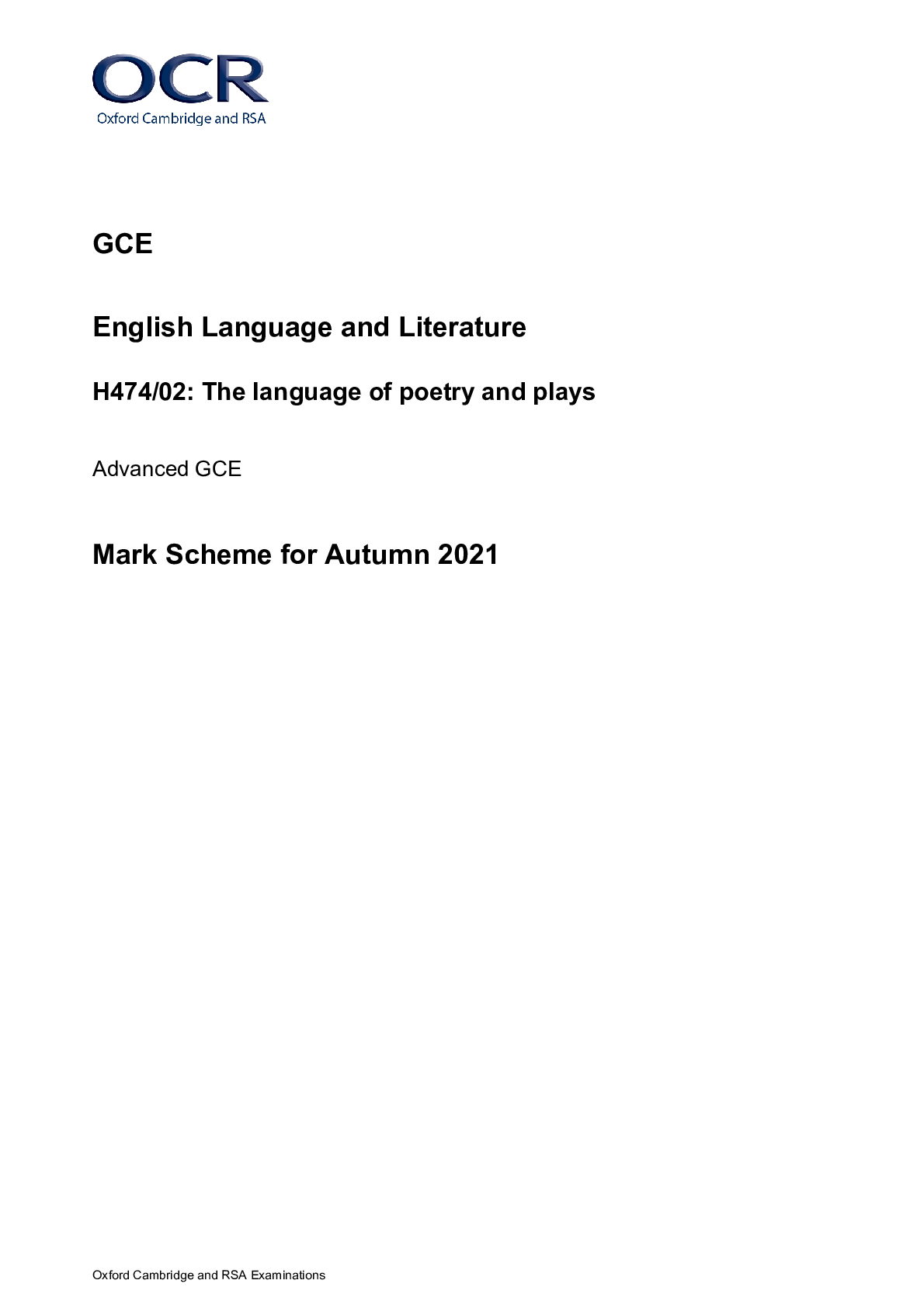English > MARK SCHEMES > OCR GCE GCE English Literature H472/01: Drama and poetry pre-1900 Advanced GCE Mark Scheme for Autum (All)
OCR GCE GCE English Literature H472/01: Drama and poetry pre-1900 Advanced GCE Mark Scheme for Autumn 2021
Document Content and Description Below
Level descriptors Section 2, Drama and poetry pre-1900 AO3 is the dominant assessment objective for this section. The weightings for the Assessment Objectives in this section are: AO3 – 50% AO4 �... �� 25% AO1 – 12.5% AO5 – 12.5% Level 6: 26–30 marks AO3 (50%) • Consistently developed and consistently detailed understanding of the significance and influence of the contexts in which literary texts are written, as appropriate to the question. • Consistently developed and consistently detailed understanding of the significance and influence of the contexts in which literary texts are received, as appropriate to the question. AO4 (25%) • Excellent and consistently detailed comparative analysis of relationships between texts. AO1 (12.5%) • Excellent and consistently detailed understanding of texts and question; well-structured, coherent and detailed argument consistently developed; consistently fluent and accurate writing in appropriate register with critical concepts and terminology used accurately and consistently. AO5 (12.5%) • Judgement consistently informed by exploration of different interpretations of texts. Level 5: 21–25 marks AO3 (50%) • Good, clear evaluation of the significance and influence of the contexts in which literary texts are written, as appropriate to the question. • Good, clear evaluation of the significance and influence of the contexts in which literary texts are received, as appropriate to the question. AO4 (25%) • Good, clear comparative analysis of relationships between texts. AO1 (12.5%) • Good and secure understanding of texts and question; well-structured argument with clear line of development; good level of coherence and accuracy of writing in appropriate register with critical concepts and terminology used accurately. AO5 (12.5%) • Good level of recognition and exploration of different interpretations of texts.H472/01 Mark Scheme October 2021 Level 4: 16–20 marks AO3 (50%) • Competent understanding of the significance and influence of the contexts in which literary texts are written, as appropriate to the question. • Competent understanding of the significance and influence of the contexts in which literary texts are received, as appropriate to the question. AO4 (25%) • Competent comparative discussion of relationships between texts. AO1 (12.5%) • Competent understanding of texts and question; straightforward arguments generally competently structured; clear writing in generally appropriate register with critical concepts and terminology used appropriately. AO5 (12.5%) • Answer informed by some reference to different interpretations of texts. Level 3: 11–15 marks AO3 (50%) • Some understanding of the significance and influence of the contexts in which literary texts are written, as appropriate to the question. • Some understanding of the significance and influence of the contexts in which literary texts are received, as appropriate to the question. AO4 (25%) • Some attempt to develop comparative discussion of relationships between texts. AO1 (12.5%) • Some understanding of texts and main elements of question; some structured argument evident, lacking development and/or full illustration; some clear writing, some inconsistencies in register with some appropriate use of critical concepts and terminology. AO5 (12.5%) • Some awareness of different interpretations of texts.H472/01 Mark Scheme October 2021 Level 2: 6–10 marks AO3 (50%) • Limited understanding of the significance and influence of the contexts in which literary texts are written, as appropriate to the question. • Limited understanding of the significance and influence of the contexts in which literary texts are received, as appropriate to the question. AO4 (25%) • Limited attempt to develop comparative discussion of relationships between texts. AO1 (12.5%) • Limited understanding of text and partial attempt at question; limited attempt to structure discussion; tendency to lose track of argument; inconsistent writing, frequent instances of technical error, limited use of appropriate register with limited use of critical concepts and terminology. AO5 (12.5%) • Limited awareness of different interpretations of texts. Level 1: 1–5 marks AO3 (50%) • Very little reference (and likely to be irrelevant) or no understanding of the significance and influence of the contexts in which literary texts are written, as appropriate to the question. • Very little reference (and likely to be irrelevant) or no understanding of the significance and influence of the contexts in which literary texts are received, as appropriate to the question. AO4 (25%) • Very little or no relevant comparative discussion of relationships between texts. AO1 (12.5%) • Very little or no connection with text, question disregarded; undeveloped, very fragmentary discussion; persistent serious writing errors inhibit communication of meaning; very little or no use of appropriate register with persistently inaccurate (or no use) of critical concepts and terminology. AO5 (12.5%) • Very little or no awareness of different interpretations of the text. 0 = No response, or no response worthy of credit.H472/01 Mark Scheme October 2021 13 Question Guidance Marks 1 (a) Coriolanus Discuss the following passage from Act I Scene i, exploring Shakespeare’s use of language and dramatic effects. In Section 1, part (a), the dominant assessment objective is: AO2. AO2, Analyse ways in which meanings are shaped in literary texts. Answers will also be assessed for AO1, Articulate informed, personal and creative responses to literary texts, using associated concepts and terminology, and coherent, accurate written expression. Answers should be informed and relevant, showing understanding of ways in which structure, form, language, imagery and dramatic effects shape meaning (AO2) blended into a coherent argument (AO1). Candidates may choose to comment on the sheer variety of ideas and characters presented in this passage. Early in the play we are plunged into an all-male world of power, politics and military threat – where exclamations, imperatives and plain rhetoric often dominate the language used by characters, as in Coriolanus’ exaltation of the worthy enemy, Aufidius. The passage presents characters jostling, arguing, disagreeing, and playing politics with each other in order to establish positions. We are also reminded that strife exists not just in terms of relationships with other states but also within Rome itself. Marcius (Coriolanus) stands out in all this, of course, with his larger-than-life character – and his use of repeated imagery of war, hunting and fighting. His language of admiration for the ‘enemy’ Tullus Aufidius reminds us of the complex loyalties revealed throughout this play. His repeated use of the pronoun ‘I’ in the passage also reminds us, perhaps, that he admires himself even more. His gratuitous attack on the common people as ‘rats’ and ‘mutineers’ is ominous in the light of later developments. The concluding dialogue of Brutus and Sicinius, also intriguingly proleptic, has a more intimate quality, though it too is generally in verse. The tribunes make tough political points about the value of working from the second rank in Roman politics (the station they themselves occupy). They discuss Marcius in terms both of his character and of his physical presence – and they create a mood of dramatic expectation as they speculate on the possible outcomes of the collaboration of Marcius and Cominius. This indicative content is intended to indicate aspects of questions that may feature in candidates’ answers. It is not prescriptive, nor is it exclusive; examiners must be careful to reward original but well-focused answers and implicit as well as explicit responses to questions. This guidance should be used in conjunction with the Level Descriptors Section 1, part (a): Shakespeare. 15H472/01 Mark Scheme October 2021 14 Question Guidance Marks 1 (b) Coriolanus ‘‘The effects of war are often unpredictable.’ Using your knowledge of the play as a whole, show how far you agree with this view of the play Coriolanus. Remember to support your answer with reference to different interpretations. In Section 1, part (b), the equally weighted assessment objectives are AO1 and AO5. AO1, Articulate informed, personal and creative responses to literary texts, using associated concepts and terminology, and coherent, accurate written expression; and AO5, Explore literary texts informed by different interpretations. Answers should be creative, informed and relevant (AO1) and supported with textual reference. The answer is in itself a response to a critical view, but may make reference to the interpretations of other audiences and readers (AO5), which may include a discussion of changing critical views of the play over time, and of both historic and contemporary performances of the play. Coriolanus is a play dominated by wars and fighting and its hero is a celebrated warrior. It could be argued that the effects of war are wide ranging: war can have an impact on the state and its structures, but can also impose significant strain on individual relationships (of the most intimate kind in the case of Coriolanus and Virgilia). The cult of arms has raised Volumnia to a brutal matriarch, Coriolanus’ son to an apprentice thug, and has Titus Lartius waving his crutches in threat long after he should have retired. The opening sequence in Corioli raises Coriolanus to the status of superhero, defeating an army singlehanded in a rival city, refusing to acknowledge ever after that deeds in the forum or the senate can compete with the garland and surname he earned there: ‘O! me alone? Make you a sword of me?’ Prowess in battle brings Marcius within reach of the Consulship, an office he is temperamentally unsuited to fill, and exposes the fundamental class division in Rome, where insolent Patricians fight wars on behalf of a resentful populace. When Coriolanus seeks ‘a world elsewhere’ he craves friendship with his great competitor, who uses their former encounters as a reason for mistrusting and destroying him. Candidates could choose to make reference to productions of the play – on stage or on film – in which the visual effects of war are highlighted. The Volscian servingmen offer intriguing and levelling commentary on the ‘thwacking’ deeds of their masters [Show More]
Last updated: 2 years ago
Preview 1 out of 31 pages

Buy this document to get the full access instantly
Instant Download Access after purchase
Buy NowInstant download
We Accept:

Reviews( 0 )
$13.00
Can't find what you want? Try our AI powered Search
Document information
Connected school, study & course
About the document
Uploaded On
Jul 10, 2022
Number of pages
31
Written in
Additional information
This document has been written for:
Uploaded
Jul 10, 2022
Downloads
0
Views
121


.png)











.png)









